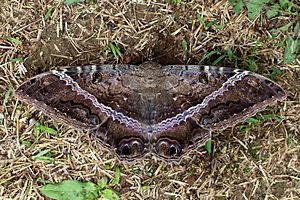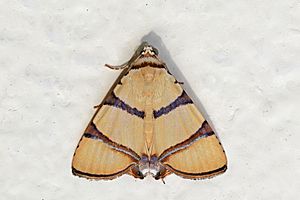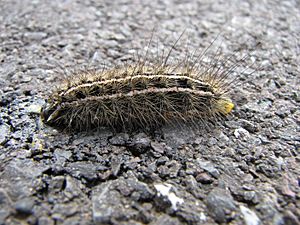Erebidae facts for kids
Quick facts for kids Erebidae |
|
|---|---|
 |
|
| Black witch moth Ascalapha odorata, Brazil |
|
| Scientific classification |
|
| Kingdom: | Animalia |
| Phylum: | Arthropoda |
| Class: | Insecta |
| Order: | Lepidoptera |
| Superfamily: | Noctuoidea |
| Family: | Erebidae (Leach, [1815]) |


The Erebidae are a very large family of moths. In biology, a family is a group of living things that are closely related. These moths belong to a bigger group called the Noctuoidea superfamily.
The Erebidae family has more species than almost any other moth family. It includes many well-known types of large moths. Some of these are the underwings (like Catocala moths), litter moths, tiger moths, lichen moths, and wasp moths. It also includes tussock moths, piercing moths, snout moths, and zales. You might even hear some Erebidae moths called "owlets."
These moths come in many sizes. Some are very big, like the black witch moth, which can have a wingspan of over 5 inches (12.7 cm). Others are tiny, with wingspans as small as 0.25 inches (0.6 cm). Their colors also vary a lot. Some Erebidae moths are dull and camouflaged, blending in with their surroundings. Others are very bright and colorful, like the tiger moths. You can find Erebidae moths on every continent except Antarctica.
Contents
What are the Erebidae Moths?
Erebidae moths are a diverse group, meaning they have many different appearances and behaviors. They are found all over the world, from forests to deserts. Many of them are active at night, but some fly during the day.
Like all moths, Erebidae moths go through a life cycle with four stages: egg, larva (caterpillar), pupa (often inside a cocoon), and adult moth. The caterpillars of these moths eat different kinds of plants. Some caterpillars are hairy, like those of the tussock moths, and can sometimes cause skin irritation if touched.
Subfamilies of Erebidae
Scientists divide the Erebidae family into smaller groups called subfamilies. Each subfamily contains moths that share certain features. Here are some of the main subfamilies:
- Aganainae
- Anobinae
- Arctiinae – These are the tiger, lichen, and wasp moths. They are often brightly colored.
- Boletobiinae
- Calpinae – This group includes some piercing moths.
- Erebinae – This subfamily includes the underwing moths and their relatives.
- Eulepidotinae
- Herminiinae – These are often called litter moths because they live among dead leaves and plant debris.
- Hypeninae – Known as snout moths because of their long, snout-like mouthparts.
- Hypenodinae – This group includes some very tiny moths called micronoctuoids.
- Hypocalinae
- Lymantriinae – These are the tussock moths, often recognized by their hairy caterpillars.
- Pangraptinae
- Rivulinae
- Scolecocampinae
- Scoliopteryginae – Another group of piercing moths.
- Tinoliinae
- Toxocampinae
How Scientists Classify Erebidae
For a long time, scientists grouped moths based on how they looked. But with new tools like DNA studies, they can now understand how different moth groups are truly related. This has changed how the Erebidae family is classified.
Before, some groups like the tiger moths (Arctiinae) and tussock moths (Lymantriinae) were thought to be separate families. Other Erebidae moths were placed in a different family called Noctuidae. However, genetic studies showed that many of these moths were actually more closely related to each other than to other moths in the Noctuidae family.
Because of these discoveries, scientists decided to create the larger Erebidae family. This new classification helps us understand the true family tree of moths. Now, groups like the Arctiinae and Lymantriinae are considered subfamilies within the Erebidae. This shows how science is always learning and updating our understanding of the natural world!
See also
 In Spanish: Erebidae para niños
In Spanish: Erebidae para niños


